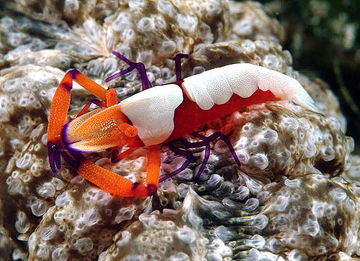430917-imperial shrimp.jpg

Imperial shrimp. Credit: Ken Bondy
When an imperial shrimp wants to get from one spot to another, it doesn’t hail a cab or an Uber — and it certainly doesn’t walk. Instead, it may catch a ride on the nearest sea slug or sea cucumber. And as payment, it tidies things up a bit.
Despite its regal-sounding name, the imperial shrimp is tiny — less than an inch long. It’s found in shallow waters in the Indian Ocean and in the Pacific from Hawaii to Asia.
It belongs to a type of shrimp that live on or near other organisms. Those organisms provide protection and food for the shrimp, while the shrimp may clean away algae and parasites from its partners.
Most of these shrimp reside on organisms that stay put, or that occasionally creep along the ocean floor. But the imperial shrimp prefers hosts that move around a bit. It’s commonly found on the back of a type of sea slug known as a Spanish Dancer — often two shrimp on the same slug. The slug is toxic to many creatures, so most predators avoid it — giving the shrimp a wide berth as well.
In return for transportation and protection, the shrimp clean off the skin of the slug, especially around its gills. And they even clean up after the slug — they sometimes eat the pellets that the slug poops.
A shrimp can stay with the same slug for a long time. But if it finds a good feeding area, it may hop off and grab a meal. And when it’s full and ready to head out, it hops on the back of another slug or other slow mover — and it doesn’t even need an app to catch a ride.

